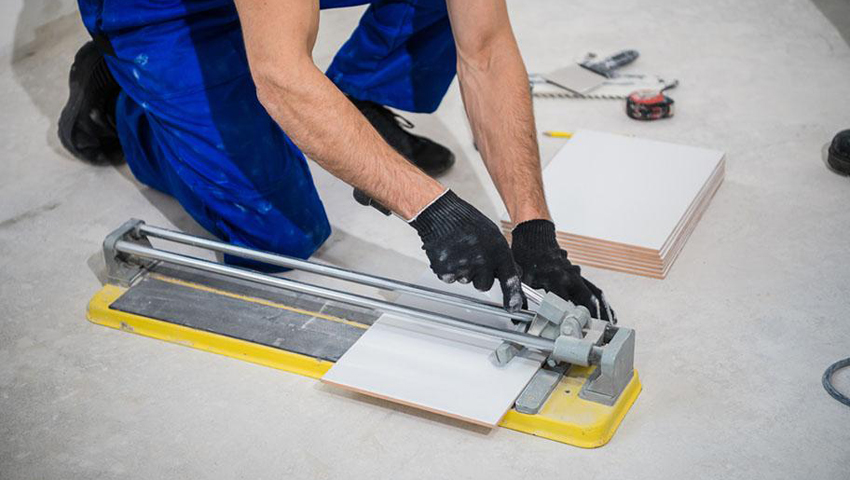
How to Cut Tile
When you've prepared your tile project and purchased your tiles, consider how to cut them. The most straightforward tile job requires some cutting, so knowing how to cut tiles is vital for creating a professional look and cutting down on wasted materials.
It's easy to learn about some of the most widely used tile-cutting tools and when to use them in this guide for DIY and new tilers.
Understanding each tool's design and considering your project's scope is essential when deciding which tile-cutting method is best for your project. 3 factors will help you decide what tool to use:
1- What type of tile you’re cutting
2- What sort of cut is needed
3- How many tiles do you plan on cutting
Determine what type of tile you are installing. Here is a quick breakdown of the most common tiles you can use.
Glass Cutter
A glass cutter is often used if the task is small and does not involve any complicated or curvy cuts. In this small hand tool, rotating wheels let you cut glass or ceramic tiles without chipping or crushing them.
When Does it Work Best? This tool is better suited for small jobs that require a few cuts.
When to Avoid? Cut corners and curves when you need to.
Is it used for a particular purpose? Glass and ceramic tiles
To mark lines, you need a square ruler, chalk or pencil, a wire hanger, and a rubbing stone
Snap Cutter
An inexpensive alternative to making tile is a rail tile cutter, or snap cutter. Power tools are not required to work as a substitute for this because it does not require electricity or water.
When Does it Work Best? Snap cutters are great for small projects when you do not have to cut a lot of tiles. Also helpful when making diagonal cuts or cuts at different angles.
When to Avoid? No curves or embossing requires a snap cutter.
The process is manual, causing it not to be suitable for large projects. Even though it makes, straight cuts, it does not create perfectly straight lines like a wet tile saw. Tiles up to 3/8 inches thick, natural stone, marble, and large format tiles shouldn't be cut with a snap cutter - they should be cut using a wet tile saw.
Used for Which Materials? Various styles are used for cutting ceramic tiles up to 3/8 inches thick. For cutting porcelain tile, it is also possible to use it depending on the texture. You can use a snap cutter to cut marble tiles, but only if it has tungsten carbide blades.
Tile Nipper
The nipper, or slitting tool, will allow you to slice tile in small snips, which is difficult to do with larger tools. However, you'll need patience as you can only cut tile in this way.
When Does it Work Best? The use of a tile nipper when you want irregular cuts is beneficial. Tile nippers are excellent tools for cutting small pieces off tiles, such as around toilet flanges, faucet valves, door cases, etc.
When to Avoid? When want to Cut off large straight pieces.
Used for Which Materials? Tile nippers are commonly used with ceramic tiles. If you want to cut porcelain, concrete, or some natural stone tiles, it has to be fully firm and squeezed. Likewise, it's useful for tile sheets with smaller sections, such as mosaic tiles.
Angled Grinder
A angled grinder is helpful for making multiple cuts in different sizes and shapes, including L cuts, circle cuts, straight cuts and square cuts. While it's not as clean as a wet saw, it'll still work since it requires less finesse. Depending on the work, you can choose electric, cordless, pneumatic, or gas-powered angle grinders. Robust and more compact angle grinders provide a lot of surface area.
Where Does it Work Best? This tool is best used for piping to cut tiles around doorways, heater vents, and even bathroom walls. It is also suitable for cutting curves instead of drilling holes in tiles.
Used for Which Materials? This tool cuts ceramic, porcelain, stone, marble, and glass tiles. Diamond-tipped, smooth-edged blades are best for cutting ceramic tiles, while notched edges suit porcelain tiles much better, and serrated edges blend well with natural stone tiles.
Wet Saw
You can use this method on large jobs that involve lots of tiles, but you need to be experienced to use it. Their tile cuts are extremely precise- they can be cut to your exact measurements and create a smooth, straight edge. The wet saw is even capable of cutting bullnose or quarter-round tile trimmings. When Does it Work Best? Wet saws are great for bulk projects! Here's the tool you need if you're cutting large sections of tile or cutting corner corners around door jambs or wall outlets.
Used for Which Materials? You can use a wet saw to cut porcelain, ceramic, marble, and glass tiles.